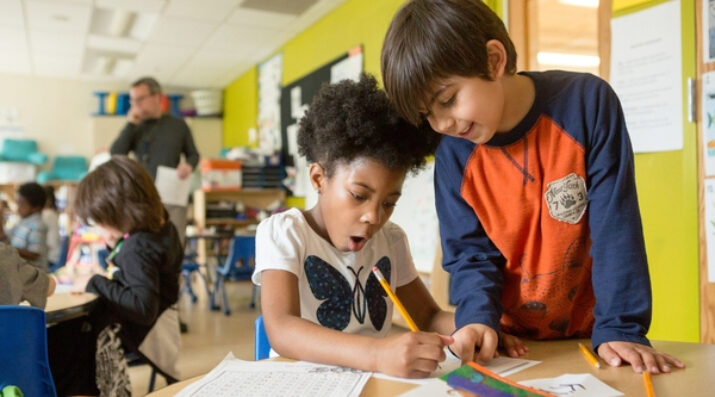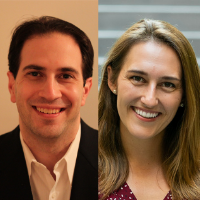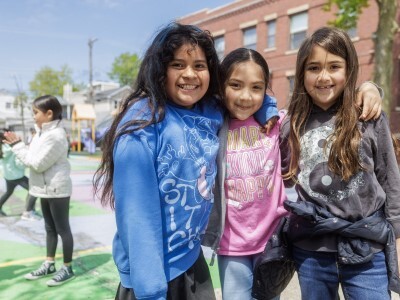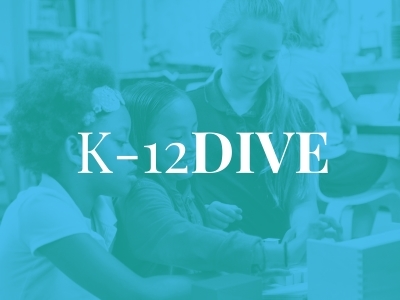Finland Meets Civil Rights
Topics

Today’s learners face an uncertain present and a rapidly changing future that demand far different skills and knowledge than were needed in the 20th century. We also know so much more about enabling deep, powerful learning than we ever did before. Our collective future depends on how well young people prepare for the challenges and opportunities of 21st-century life.
We can get to better educational experiences and outcomes for all youth if we look to the best ideas from both advocates of Finland's approach and the civil rights community.
Since the beginning of the No Child Left Behind era, there has been a schism between what you might think of as the “Finland folks” and much of the civil rights community, particularly its policy and legal advocates. In this post, we explore what is valuable about each approach to education reform, why they have been at odds with each other, and what a new synthesis might look like.
On one side, the “Finland folks” are champions of teacher professionalism. They point to the Scandinavian nation’s success as evidence that if we in the United States prepared teachers as well and supported students with as strong a welfare state, there would be no need for the heavy-handed test-based accountability that we currently have. Underlying this vision is a conception of teaching as highly complex and skilled work that cannot be easily rationalized. That’s why these advocates are skeptical of rote standardized tests or simplistic approaches to teacher evaluation, which they see as deskilling the profession—applying a neo-liberal logic to what should be a professional sphere. The U.S. educational system is full of mistrust, which is the main root of our problems; we need to train the professionals, and then trust them, if we are to make significant and sustainable progress.
Not so fast, many in the civil rights community respond. We have trusted the (largely White) professionals for years—and where has it gotten us? Generation after generation promises are made and broken, and the students who most need education to provide upward mobility end up with the short end of the stick. Bobby Kennedy, when discussing the original ESEA in 1965, expressed skepticism that more money would matter without accountability for results, and Ted Kennedy adopted a similar stance when he partnered with George W. Bush to pass No Child Left Behind in 2001. For years, organizations like Education Trust have been bullish on test-based accountability precisely because, they contend, it pushes schools to focus on students who are least well served by the existing system. Without accountability for school performance, the specter of racism will inevitably rise up to defeat any well-intentioned efforts toward school improvement.
As students and teachers succeed, public trust develops, which lessens the need for high-stakes testing.
Further complicating this conundrum is our country’s history of racial discrimination and obstructionism. The modern civil rights movement is heavily shaped by its legal history, throughout which Whites and advantaged communities have strongly resisted efforts to desegregate schools or equalize funding across schools. Particularly among lawyers who grew up with Thurgood Marshall and others like him as their heroes, it is almost an article of faith that states, districts, and schools cannot be trusted to do right by students of color, and that change will not come without policy, legal pressure, and even state coercion.
So, who is right, and what should we do? We think that each group is right about different parts of the equation, and that, therefore, a new and different synthesis is needed.
What the Finland Advocates Get Right
One particularly important dimension of the Finnish approach is that it is grounded in systems thinking. Finland offers a theory of how all the pieces fit together—extensive initial training prepares teachers to teach, and sufficient welfare state support ensures that children come to school ready to learn. Schools are part of a robust network of social institutions designed to prepare all children for success in our changing world. Students thus perform well by international standards. As students and teachers succeed, public trust develops, which lessens the need for high-stakes testing. In such a system, teaching is an attractive profession, which makes many young people want to become teachers, which in turn allows the system to be selective in whom it accepts. A positive reinforcing feedback loop sustains this process.
Relatedly, the Finnish approach is right about culture and sustainability. Finnish teachers are trusted and respected, which makes them want to stay in the profession, and creates the career longevity that is needed for long-term improvement. Unlike many U.S. reformers, who often counterpose the needs of students to the needs of teachers, the Finland proponents emphasize that long-term improvement requires building institutions and policies that are good for both students and teachers. In the absence of such culture and support, they rightly argue, teaching in the United States is often like a revolving door, which makes it nearly impossible to sustain any strategy of improvement.
The Finns are also right in their understanding of the seriousness and complexity of teaching as a task. Finnish teachers spend a year doing a thesis on an instructional issue of interest to them, an immersive experience which establishes the precedent that improving teaching is an iterative process that ties together external research, local knowledge about context, learning by doing, and reflection on action. Particularly as the goals for teaching become more ambitious—deeper learning, culturally responsive pedagogy, and 21st-century skills—helping teachers grow and extend their practice must be at the center of any serious effort at educational improvement.
What the Civil Rights Community Gets Right
At the same time, the civil rights community is right to insist upon the importance of context while engaging in school improvement work. In response to advocacy that seeks to bend the U.S. public system toward the Finnish model, many civil rights advocates point to our country’s size and diversity. Our nations are so different, they say. The “Finnish approach” will not work in the United States. Indeed, in Finland, the effort to transform its own public education system was part of a sweeping governmental effort in the 1970s to shore up national resources and strengthen the nation’s welfare state. Finland was losing thousands of workers to its wealthier neighbor, Sweden, and the Soviet Union was eager to maintain as much control over Finland as possible. Even today, educational reforms in Finland are framed as part of the country’s national defense plan. Excellent education for all is part of the nation’s response to Russian aggression as well as to international economic competition.
Unlike Finland, for most of our history the United States has been a wealthy, powerful, and isolated nation that has not had to contend with serious attacks on our sovereignty or independence. Educational equity is therefore not treated as a national security imperative in the United States as it is in Finland. Furthermore, the history of the United States is a structurally unequal one, full of policies and practices that have led to huge economic gains for European-Americans at the expense of African-Americans, Latinos, and Indigenous peoples in North America. To take two examples, chattel slavery and aggressive land acquisition policies which displaced millions of people contributed to the creation of one of the most powerful economies in the world. In the United States, we do not have a history of prioritizing equity in our social or economic policies—but we do have a history of world power and national sovereignty.
Given this starting point, the civil rights community rightly presses for forms of accountability and transparency that can monitor school transformation efforts in the United States. The United States is not Finland, and given the racial and economic history of this country, trust is not going to be given blindly to the government or its schools. Accountability doesn’t (and, in our view, shouldn’t) mean high-stakes testing, but the idea that public (i.e., government-funded) schools have to show that they are working for all of their students must remain central.
Civil rights advocates are also right about the ways in which implicit bias, interpersonal racism, and structural inequities systematically disadvantage students of color and higher poverty students in our nation. The evidence on macro inequities has been obvious for years, and more recent work has shown the subtler dynamics of implicit and cognitive biases. There are not many examples on the global stage of excellent, equitable school systems in a multicultural society—in fact, there is evidence that shows that as nations become more culturally diverse, equitable schooling is more difficult to maintain.
Civil rights supporters have a rich body of literature to draw upon that describes culturally responsive and sustainable teaching practices.
The good news is that civil rights supporters have a rich body of literature to draw upon that describes culturally responsive and sustainable teaching practices. While much of the civil rights law world has in the past focused on test scores, there is a different, more pedagogically focused, tradition amongst scholars and activists of color that could be useful for building better schools. For instance, Paulo Freire famously argued that we needed to move away from “banking” education and toward education for liberation. Scholars like Gloria Ladson Billings and Geneva Gay have developed a research base on culturally-responsive teaching, suggesting the importance of understanding students’ racial and cultural backgrounds, creating racially-affirming relationships, drawing on culturally-relevant materials, believing strongly in students and holding them to high standards, and examining one’s own racial identity and assumptions. Gholdy Muhammed finds that many of these same attributes were present in Black literary and abolitionist societies of the 19th century and offers a roadmap for equitable teaching that develops students’ identities, skills, intellectualism, and critical awareness of the world. Recent contributions by Bettina Love on “abolitionist teaching” and Zaretta Hammond on “culturally responsive teaching and the brain” offer practical approaches to teaching students of color in ways that are infused with purpose, rigor, and joy. This scholarship is well-established in pockets of the educational sector in the United States, and due to its efficacy and relevance, even Finnish teacher-preparation programs use some of this research to inform their own teachers’ training and practice.
The Best of the Finland and Civil Rights Approaches
So how might we put these pieces together? What would it look like to build schools—and school systems—that would combine the best parts of the Finnish approach with the distinctive U.S. context?
The first thing to notice is that there is a potential for strong overlap in the pedagogical goals. Deeper learning, as developed in the writings of Dewey, Piaget, and other champions of inquiry-oriented education, has much in common with the liberatory, culturally responsive, abolitionist approach championed by Freire, Ladson-Billings, Love, and others. The latter approach is more critical and context-specific—it is more attentive to inequities in the distribution of power and seeks to unmask the ways in which these inequities are maintained. Yet it shares the goals of inspiring critical thinking and seeking deeper understanding. Both inform the Finnish approach to teacher training and both address civil rights concerns here in the United States. These inquiry-oriented and culturally-responsive theorists share the fundamental sense that education is meant to be human—that there is a person whose needs, interests, and ideas must be respected. In fact, preparing teachers for the ethical dimension of their work plays a key role in Finnish teacher education. Humane and dignified treatment is important for all students but will require particular effort—and reimagining of our education systems—if schools are to become welcoming, identity-affirming, relevant places for students of color in the United States. This is an agenda we should all be able to get behind.
More consequential learning and change comes from connecting learning about inequity with learning about practice, ideally in a positive reinforcing cycle.
These reimagined classrooms suggest a second area of overlap: taking a rich and multidimensional view of the purpose of schools as places to raise thoughtful, thriving, and flourishing young people. One aspect of the Finnish system that strikes visitors is that the goal of schooling is not seen to be solely academic but rather to raise thriving young people. And one thing that has been noticeable about more recent work that emphasizes Black liberation—“we want to do more than survive” as Bettina Love puts it—is that it similarly raises our aspirations for schooling. Creating rich educational experiences in the United States for students of color requires race-conscious strategies—being aware of the complexities that come with being a person of color in this society—to achieve the ultimate goals of students being seen, heard, known, and thriving.
How might we create such experiences for students? As Jal has written elsewhere, the evidence indicates that anti-bias training, of which White privilege workshops are the most recent manifestation, has limited impact. In our view, such training is insufficient in light of the complexities of teaching. Rather, we think that more consequential learning and change comes from connecting learning about inequity with learning about practice, ideally in a positive reinforcing cycle. So if the goal is to help teachers become culturally responsive and sustaining professionals, they need to be part of ongoing communities which can help them investigate their practices using a racial justice and anti-bias lens. They also need opportunities to connect more deeply with their students, to see them as full human beings rather than as scores on a grade-sheet. That, in turn, may require significant and far-reaching structural changes in schools—smaller teaching loads, more professional autonomy for teachers, more time for professional learning and planning, and more opportunities to connect with students, families, and other people outside of schools who have relevant knowledge. Finnish elementary school teachers frequently loop to build deep relationships with their students; some schools in the United States do this but it could become a more common practice. Such change will require leadership—district leaders, school leaders, and teacher leaders who will model building trusting relationships, connecting across lines of differences, insisting upon equitable distribution of resources, and remaking schools as more human and humane institutions.
A fourth area of agreement is about supporting students and their families outside of school. Record levels of inequity—not just in income, but also in housing, health, and overall living conditions—are ravaging the United States. A large part of the success of the Finnish educational system stems from the much more robust Scandinavian welfare state which surrounds and supports it. In the United States, there could be a shared emphasis on the importance of lessening social inequities through strengthening social policy in all aspects of family welfare, as well as by providing increased counseling and other supports for students within schools. Community schools, Comer schools, trauma-informed schools, Harlem Children’s Zone, and other such approaches could be part of this shared agenda.
A fifth shared item is teacher preparation, recruitment, retention, and pay. As the Finnish system shows, strengthening teacher preparation is the foundation of any strong system. In the United States, teacher preparation is where teacher candidates could learn many of the multifaceted skills that they need to inspire and support students. The National Commission on Teaching for America’s Future, of which Jal was a member, suggested that every teacher in America should engage in one year of residency, which would help to lessen the endemic of unprepared teachers teaching our most marginalized students. The combination of better teacher preparation and better support of students outside of school would increase teacher retention rates in the United States. These steps would allow us to get off the treadmill of teachers rapidly leaving the field and a massive shortage of new teachers entering it. Change needs to be anchored by a new commitment to increased teacher pay, which would help to diversify the field, especially for first-generation college-goers who need to be offered a decent salary if they are going to be persuaded to become teachers.
The final and perhaps most complicated question is about accountability. That has been the biggest source of disagreement between the two groups. We think the answer here lies in a more dynamic view of trust. Accountability in the U.S. has historically been promoted by civil rights advocates and bemoaned by the Finland folks. Accountability policies in the United States started from fundamentally broken relationships and a premise of distrust across the entire structure of education. Because they are distant from the work in schools, state and district policymakers assume that the people in schools cannot be trusted and need to have their feet held to their fire to motivate them to produce. A healthier approach would be much more dynamic and relational: a school would work with its outside partners—parents, community members, district officials—to try to define what everyone would see as success, what would count as evidence of that success, and what role each partner could play in producing that success. Trust thus becomes a reciprocal process: trust is earned over time as promises are met and needs are fulfilled. Especially given the ways in which schools (and policy officials) have long failed students of color, actions will initially matter more than words; as schools show through their actions that they care about students, that they are competent, and that they follow through on what they say they will do, trust will gradually accumulate.
Such a dynamic vision of trust is particularly compatible with the visions of learning and human flourishing described above. When parents turn their children over to schools, they want the teachers and administrators to treat those children as if they were their own—building their academic skills, yes, but also offering a hug when needed, helping them when they struggle, and encouraging them not only to think but also to become well-rounded and thriving human beings. Many in the Black community have fond memories of pre-desegregation Black schools, because, despite the lack of financial resources, there was a sense of shared mission, cultural understanding, and, dare we say, love, between Black students and their Black teachers. We are trying to rebuild some of those qualities in what are now multi-racial settings, but we are trying to do this without attending to our own specific history and context—including our nation’s history of racial distrust and the way that segregation and structural racism have created such different life experiences for White teachers and students of color. If we are to succeed in a nation marked by inequity and division, the only way to do so is to gradually accumulate trust, through a series of small actions that show that schools are worthy of such trust.
The United States is not Finland. Our size, wealth, and most of all racial and economic history mean that we cannot simply import the Finnish approach. But we can draw on Finnish lessons while making them more relevant to our complex, multi-racial, and systemically inequitable context. That might help us build shared responsibility instead of finger pointing, policies based in trust instead of distrust, and schools where Black and Brown students thrive instead of merely survive.
Photo at top by Allison Shelley for American Education: Images of Teachers and Students in Action.




